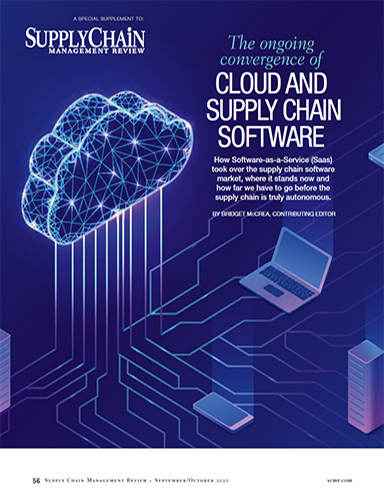The Ongoing Convergence of Cloud and Supply Chain Software
How Software-as-a-Service, SaaS, took over the supply chain software market, where it stands now, and how far we have to go before the supply chain is truly autonomous. Plus the entire issue of September/October 2020 Supply Chain Management Review articles.
Supply Chain Cloud Services
The worldwide public cloud services market was on track to grow by 17% for a total of $266.4 billion in revenues this year - up from $227.8 billion last year.
“At this point, Cloud adoption is mainstream,” Gartner’s Sid Nag pointed out at the time. “Adoption of next-generation solutions are almost always ‘Cloud-enhanced’ solutions, meaning they build on the strengths of a Cloud platform to deliver digital business capabilities.”
Breaking the Cloud down into two different segments, Gartner said software as a service (SaaS) will claim $116 billion of the market in 2020, while Infrastructure-as-a-Service (IaaS) will hit $50 billion. Gartner attributes much of the growth to the demands of modern applications and workloads, “which require infrastructure that traditional data centers cannot meet.”
Safe to say, COVID-19 will elevate those numbers even further as companies scramble to find technology that supports more remote, socially distanced work arrangements. So, while Cloud adoption was already on the rise - with very few companies doing big, on-premise software installations anymore - it’s taking on a larger responsibility as organizations invest in applications that help them be more flexible, agile, and resilient.
Supply Chain Software
Supply chain software has been front-and-center in many of these conversations. Valued at over $15 billion, the supply chain management (SCM) sector grew at an 8.6% pace in 2019, exceeding $15 billion in vendor revenue by helping companies automate and manage their domestic and global supply networks.
According to Balaji Abbabatulla, Gartner senior director analyst of product management research for SCM software, Cloud software revenue grew almost 2-1/2 times faster than the overall SCM market in 2019. In total, it accounted for nearly 34% of the market as all leading vendors in the space took their new product strategies into the Cloud.
“The impact of Cloud has been all-pervasive across all of the supply chain submarket segments,” Abbabatulla points out. Gartner divides those segments into procurement, supply chain planning (SCP), and supply chain execution (SCE) applications. For procurement, he says many of the procurement platforms being adopted right now are Cloud-based, and many of their users are accessing those platforms remotely (via the Cloud). “It’s really about usage and adoption,” he says.
In the SCP space, Abbabatulla is seeing a big push for legacy software modernization that’s being supported by the adoption of Cloud-based applications. Much of what’s in place right now is antiquated, so companies are looking for new ways to be able to react quickly across multiple time horizons. Cloud is helping them achieve those goals and more.
What’s Related

Favorites





